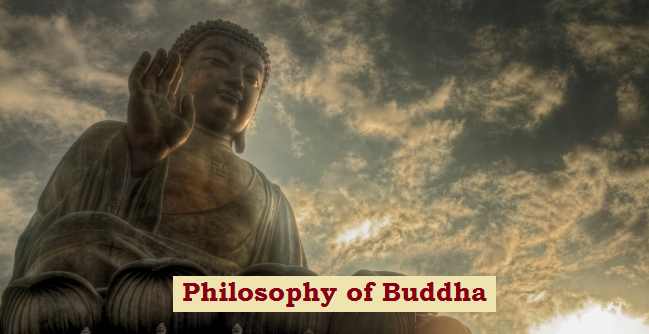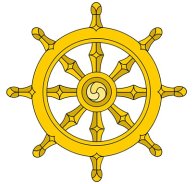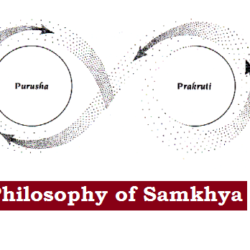

Buddhist Philosophy is one of the Nastika or Heterodox Schools of Indian philosophy. Most Buddhist traditions emphasize on the attainment of Nirvana-ending the cycle of death and rebirth by conquering desires.
In Buddhism, the three marks of existence (Trilaksana) are three characteristics of all existence and beings, namely impermanence (Anicca or Anitya), non-self (Anatta) and suffering (Dukkha). It asserts that the delusion about these three marks results into suffering (Dukkha) on account of desires and recommends an Eight Fold Path (Ashtanga Marg) of meritorious life for the elimination.
Like those of the Mahavira, Buddha’s doctrines were formulated as a reaction to and rejection of Brahmanism (a religion based on the Hindu scriptures, the Vedas and Upanishads) which was then taking shape. Therefore, it is a Nastika or Heterodox Schools of Indian philosophy.
Four Nobel Truths
It provides the insight about the universal truth- suffering (Dukkha) and its ending. They are:
1. Dukkha: there is suffering in the world
- All forms of existence are subject to suffering. Birth, sickness, old age, death, anxiety, desire, and despair, all such happenings and feelings are based on suffering.
- The concept of Dukkha can be understood from three aspects:
- Dukkha as ordinary suffering (Dukkha-Dukkha): birth, sickness, old age, death, separation from the beloved, grief, distress, etc.
- Dukkha as produced by change (Viparinama-Dukkha): impermanent happiness that will change sooner or later and then produces pain, suffering or unhappiness.
- Dukkha as conditioned states (Samkhara-Dukkha): A being or an individual has five aggregates of attachments: matter, sensation, perceptions, mental formations and consciousness. There is no other realist behind these aggregates to experience Dukkha.
2. Dukkha Samudaya: the suffering has a cause/origin
- Buddhism explains suffering through a chain of twelve causes and effects, commonly known as the Doctrine of dependent origination (Pratityasamutpada).
- In the final analysis, the root of all miseries is desire (Tanha).
- Desire is all pervasive; desire for possession, enjoyment, and a separate individual existence are some of the virulent forms of desire.
- As long as there is the ‘thirst’ (desire) to exist, the cycle of continuity (Samsara) continues.
3. Dukkha Nirodha: there is a cessation of suffering
- Desire has to be extinguished to stop suffering.
- Nirvana (liberation) is the state of being without suffering with supreme happiness and bliss.
- It is the cessation (Samsara) of continuity and a state of ‘happiness without sensation’.
4. Dukkha Nirodha Magga: there is a path to end of suffering
- By following the practice of eightfold virtue (Ashtanga Marg) Dukkha can be destroyed. The eightfold path is the practical application of the four noble truths.
- The eight divisions will help a person to grow in ethical conduct (Sila), mental discipline (Samadhi), and wisdom (Panna).
- This is also known as the ‘middle path’ because it avoids the extremes- happiness through sense pleasures and happiness through severe asceticism.
Pratityasamutpada
(Doctrine of dependent origination)
The doctrine of dependent origination is central to Buddhist philosophy and is connected to the second noble truth– suffering has a cause (Dukkha Samudaya). Pratityasamutpada is a middle path between Sasvatvada (the principle of eternity) and Uchedvada (the principle of annihilation).
According to Sasvatvada, some things are eternal, uncaused, and independent and according to Uchedvada, nothing remains after the destruction of things. By maintaining a middle way between both these principles, Pratityasamutpada holds that things have existence but they are not eternal and they are not annihilated completely. Thus, it is a middle path where the world is neither a being nor a non-being.
According to Buddhism everything in this world has a cause. There is a cycle of twelve such causes and corresponding effects which governs the entire life of human beings.
The cycle of twelve links (Nidanas) of Pratityasamutpada is:
- Ignorance (Avidya): Ignorance is caused by desire. It causes the individual to think of himself as separate from the entire world and this leads to attachment to life and thus to suffering.
- Predisposition (Samskara): Samskara is caused by ignorance. It can be understood as the attitude and aptitude of the past Karma. There are three types of predisposition: bodily, verbal and mental.
- Consciousness (Vijnana): Consciousness is caused by predispositions. There are six types of consciousness related with: eye, ear, nose, tongue, body and intellect.
- Name and form (Namarupa): It is caused by consciousness which is the psycho-physical body in the womb of the mother.
- Sense organs (Sadayatana): The sense organs are caused by name and form. There are six sense organs such as the eyes, the ears, the nose, the tongue, the skin, and the mind.
- Contact (Sparsa): Contact with the object of enjoyment is caused by sense organs.
- Sensation (Vedana): Sensation is caused by contact with the objects of enjoyment.
- Thirst (Trisna): Thirst for enjoyment is caused by the sensation of enjoyment. Due to it a person blindly longs for worldly attachments. There are six forms of thirst with respect to: forms, sounds, smells, tastes, touch, and ideas.
- Attachment (Upadana): Attachment to sensory enjoyment is caused by the thirst for such enjoyment. There are four types of attachment: sensual, view, practice and self.
- Becoming (Bhava): It is the will to be born caused by attachment. It includes thoughts and actions which are responsible for rebirth. There are three kinds of becoming: sensual, form and formless becoming.
- Birth (Jati): Birth is caused by becoming. The Jiva is caught up in the wheel of the world and remains in it till it attains Nirvana. It refers not just to birth but rebirth and also the acquisition of a new status or position.
- Old Age and Death (Jaramarana): Old age and death are caused by birth. Rebirth causes the whole chain of the worldly sufferings. After a man is caught in the wheel of the world, diseases, old age, suffering, death, etc. recur.
Among these twelve links the first two are related to our past life, the last two to future life and the rest to present life. Hence, it is considered as the cycle of birth and death. It is the vicious circle of causation which never ends with death. Death is regarded as the beginning of a new life. It is called Bhava-chakra. The twelve links of dependent origination can be destroyed only when its root cause ignorance is destroyed.
The doctrine of Pratityasamutpada opposes to Accidentalism (events on accident), Naturalism (effect on inherent nature), Fatalism (events by fate) and Supernaturalism (event by God). Hence, Buddhism accepts that all existences physical and psychical are subject to the law of universal causation. Nothing is uncaused and eternal.
Ashtanga Marg
(Eight fold path)
Buddhism prescribes a disciplined wisdom, morality and mediation based an eightfold virtue (Ashtanga Marg) than can destroy the suffering. The eightfold path is the practical application of the four noble truths. The eight virtues will help a person to grow in ethical conduct (Sila), mental discipline (Samadhi), and wisdom (Panna).
This is also known as the ‘middle path’ because it avoids the extremes- happiness through sense pleasures and happiness through severe asceticism.
The components of it are:
- Right view (Samyak-Dristi): an accurate understanding and acceptance of the nature of things, specifically the Four Noble Truths.
- Right intention (Samyka-Sankalpa): avoiding thoughts of attachment, hatred, and harmful intent.
- Right speech (Samyak-Vac refraining from verbal misdeeds such as lying, divisive speech, harsh speech, and senseless speech
- Right conduct (Samyak-Karma): refraining from physical misdeeds by practicing five moral vows namely: non-violence (ahimsa), truthfulness (satya), non-stealing (asteya),
- Right livelihood (Samyag-Ajiva): avoiding luxurious life and trades that directly or indirectly harm others, such as selling slaves, weapons, animals for slaughter, intoxicants, or poisons, etc.
- Right effort (Samyak-Vyayama): abandoning negative states of mind that have already arisen, preventing negative states that have yet to arise, and sustaining positive states that have already arisen.
- Right awareness (Samya- Smrti): awareness of body, feelings, thought, and phenomena
- Right concentration (Samyak-Samadhi): single-mindedness which leads to Nirvana, the state of the cessation of suffering and the goal of Buddhism.
- Wisdom (Prajna) based virtues: right view and right intention; related to consciousness and knowledge
- Morality (Sila) based virtues: right speech, right conduct, and right livelihood; deal with the correct and morally right way of living.
- Meditation (Samadhi) based virtues: right effort, right awareness, and right concentration; deal with meditation and contemplation.
Anatmavada
(Doctrine of non-soul (Anatta))
Buddhism is unique in denying the existence of a soul or Atman. It is the view that there is no unchanging, permanent self, soul or essence in phenomena.
The physical material is impermanent, whatever is impermanent is the cause of suffering, and whatever is suffering is non-self. Similarly, sensations, mental formations, and consciousness cannot constitute the self because all these are transient.
It is the consequence of the doctrine of dependent origination. Buddhism analyzes the person through the five aggregates or groups (Panch Skandhas), and then attempting to show that none of these five components of personality can be permanent or absolute.
Panch Skandhas: 5 aggregates of an individual
- Form (matter): that can be sensed using five senses.
- Sensation or Feeling: experience (pleasant, unpleasant, and neutral) of five senses and the mind.
- Perceptions: capacity to conceptualize and recognize things like sight, smell, etc.
- Mental formation: impulses (hate, greed, etc.) based on biases, prejudices, interests etc.
- Consciousness: awareness using other Skandhas.
Anything a man thinks he is or he has, fall under one of these groups. The self or soul is simply an abbreviation for the aggregate of these Skandhas, and not some entity over and above the aggregate. Thus there is no distinct substance known as the ‘self’ or ‘soul’ which is permanent and unchanging.
However, Buddha does not deny man as a self or a soul but rejects the permanent and unchanging substantial self.
Kshanikvada
(Doctrine of momentariness)
According to Kshanikavada, everything is momentary, relative, conditional, and dependent. It is also known as the doctrine of impermanence (Anityavada). Buddhism teaches the impermanence, momentary nature of the world and its objects. None of them is substantial. They are appearances empty of substance or reality (Sunyata).
It is also the consequence of the doctrine of dependent origination. Every object comes into existence from an antecedent condition and gives rise to a consequent object. It is comparable to the flame of a lamp, where the flame is merely the continuity of successive flames.
According to Buddha, the existence is transformation. It is a series of successive states. All things undergo changes indicated in Utpada (origination), Sthiti (staying), Jara (growth) and Nirodha (destruction).
This doctrine is ultimately to dissuade people from placing confidence in the world and persuade them to renounce it for the permanent status of Nirvana. It avoids two extremes: Eternalism and Nihilism. Thus, it is a middle path where the world is neither a being nor a non-being.
Three Jewels: Triratna of Buddhism
All forms of Buddhism revere and take spiritual refuge in the “three jewels” (Triratna): Buddha, Dharma and Sangha.
- Buddha: while all varieties of Buddhism revere “Buddha” and “Buddhahood”, they have different views on what these are. However, “Buddha” is still central to all forms of Buddhism.
- Dharma: refers to the Buddha’s teaching which reflects the true nature of reality.
- Sangha: refers to the monastic community of monks who have chosen to follow the Buddha’s ideal way of life, which is one of celibate monastic renunciation with minimal material possessions

 Home
Home Syllabus
Syllabus Contact Us
Contact Us





2 thoughts on “Philosophy of Buddha (बोद्ध दर्शन): Pratityasamutpada, Ashtanga Marg, Anatmavada, Kshanikvada (प्रतित्यसमुत्पाद, अष्टांग मार्ग, अनात्मवाद, क्षणिकवाद)”